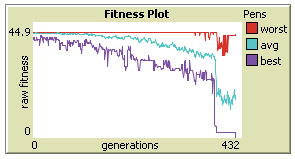Summary:
I decided that I had to drop Greedy Grazers. At least... mostly. The decision does not make me particularly happy, but the truth of the matter is that I just don't have time to make it while still polishing the maze models. I will still have two models to present (well, three or four, if you count the Maze Maker model, and the GP Example Toolkit, but they're not really full models). That is, there are two versions of the maze program -- one which evolves the full directions (right, left, forward) to find the solution to a given maze, and one that evolves the rules by which to move in each given step, based on the presence of walls, etc. The two models exhibit fairly different behavior, and make use of the GP Library in slightly different ways.
(Sometimes
it takes many generations to reach the goal...)